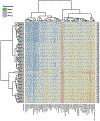Urinary metabolites as a predictive marker for perinatal depression: A secondary analysis of the mothers, Omega-3 & Mental Health Study
- PMID: 35958051
- PMCID: PMC9364841
- DOI: 10.1016/j.psycom.2022.100046
Urinary metabolites as a predictive marker for perinatal depression: A secondary analysis of the mothers, Omega-3 & Mental Health Study
Abstract
Background: Perinatal depression has been associated with unfavorable pregnancy and childhood development outcomes; however, no objective markers exist to identify perinatal mood disorders. We investigated whether metabolites in maternal urine during pregnancy can predict increased depressive symptoms in late pregnancy and postpartum among pregnant women at risk for perinatal depression.
Methods: We evaluated metabolomic markers in urine collected at 12-20 and 34-36 weeks' gestation. We analyzed 49 urinary metabolites using ion pairing reversed-phase liquid chromatography-mass spectrometry. Depressive symptom severity was identified using Beck Depression Inventory (BDI) scores from 105 participants at 12-20 and 34-36 weeks' gestation, and 6-8 weeks' postpartum. Mixed model repeated measures analysis evaluated associations between changes in maternal urinary metabolites and BDI scores across pregnancy.
Results: Increases in urinary xanthine and hypoxanthine were positively associated with increases in maternal depressive symptoms throughout pregnancy (p = 0.03 and 0.02, respectively). This finding did not persist after false discovery rate correction. None of the urinary metabolites examined were significantly associated with development of postpartum depressive symptoms.
Limitations: This study is an exploratory secondary biologic sample analysis from a trial whose sample size was determined by a different primary outcome and expected effect size, which may have limited statistical power to detect associations between urinary metabolites, depressive symptoms, and mood trajectory over time.
Conclusions: Increasing concentrations of xanthine and hypoxanthine were associated with increasing depressive symptoms throughout pregnancy. Further research is needed to evaluate the utility of these metabolic markers in identifying women at risk for perinatal depressive symptoms.
Keywords: Depression; Metabolomics; Perinatal; Postpartum; Screening.
Conflict of interest statement
Conflict of interest The authors declare that they have no conflicts of interest.
Figures



References
-
- Agren H, Niklasson F, Hallgren R, 1983. Brain purinergic activity linked with depressive symptomatology: hypoxanthine and xanthine in CSF of patients with major depressive disorders. Psychiatr. Res 9, 179–189. - PubMed
-
- Ali-Sisto T, Tolmunen T, Toffol E, Viinamaki H, Mantyselka P, Valkonen-Korhonen M, et al., 2016. Purine metabolism is dysregulated in patients with major depressive disorder. Psychoneuroendocrinology 70, 25–32. - PubMed
-
- American Psychiatric Association, 2013. The Diagnostic and Statistical Manual of Mental Disorders, fifth ed. American Psychiatric Association, Washington, DC.
-
- Beck AT, Steer RA, Carbin MG, 1988. Psychometric properties of the Beck depression inventory: twenty-five years of evaluation. Clin. Psychol. Rev 8, 77–100.
-
- Beck AT, Ward CH, Mendelson M, Mock J, Erbaugh J, 1961. An inventory for measuring depression. Arch. Gen. Psychiatr 4, 561–571. - PubMed
Grants and funding
LinkOut - more resources
Full Text Sources
